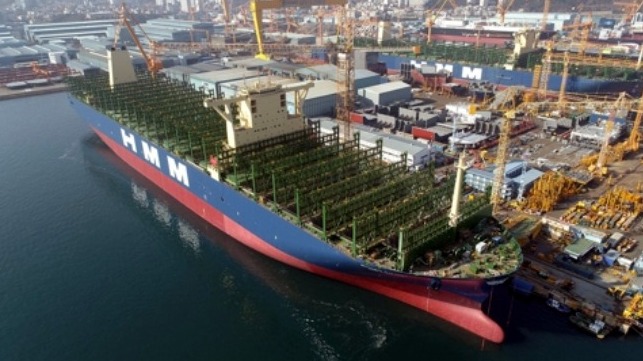Containership Orders Set Record in 2021, Closing in on All-Time High

The rush by carriers to increase capacity in the face of new highs in freight rates and record volumes coming from Asia has led to a new record being set for the total containership capacity ordered in a single year. Just eight months into 2021, the orderbook has nearly doubled since the beginning of the year and stands at three-quarters of the all-time high reached 13 years ago.
Cash-rich shipowners rushed to order new containerships, and with four months left in the year and rampant rumors of more large orders, more records could well be broken. According to an analysis of the new construction orders by industry trade group BIMCO, a total of 381 containerships have been ordered in 2021 representing a nominal capacity of 3.44 million TEU. Never, says BIMCO, has that level of container capacity been ordered in such a short period of time.
The total orderbook for containerships now stands at 5.3 million TEU up from just 2.5 million at the beginning of 2021. While it is not yet a record for the all-time high in the containership capacity on order, there are still four months in 2021. The all-time high currently stands at 6.8 million TEU that were on order at the end of July 2008.
“Shipowners are going big on investing in new capacity,” says Peter Sand, BIMCO’s Chief Shipping Analyst. “It is very much a sign of the times too; you go big, or you don’t go at all. You order four, five, or six ships, or as much as 20 units, in one go, and at one yard only. The buying power when you spend $2.5 billion is significant.”
While the shipping lines are anxious to add capacity, they are also being very strategic in their investments. Because the ships must remain versatile, capacity is not the sole determinant in the order. “Your ships must be ready to fit emerging trade lanes,” notes Sand highlighting the instead of going solely after the largest capacity carriers are tailoring orders to specific market needs.
In February, March, April, and June, a total of 60 container ships with a cargo carrying capacity of 16,000 TEU each were ordered by just five different owners. Half of them were ordered by two Top-4 tonnage providers and one minor, while the other half was ordered by operating liner companies.
As owners have observed different trade patterns forming in recent years, and still do, BIMCO highlights that the more “versatile” 13,000-16,000 TEU ships have been preferred to the Ultra-Large Containerships. Only 22 of the orders during the first seven and half months of 2021 were for Ultra-Large containerships. In February, 14 vessels of 24,000-24,100 TEU ships were ordered and in June, another eight units of 23,500-24,000 TEU followed.
In particular, for the larger ships, that lower their voyage costs the most from consuming the less costly heavy-sulfur fuel oil (HSFO). Out of the 168 ordered container ships year-to-date, with a capacity of at least 11,800 TEU, 71 percent (117 ships) will be delivered with a scrubber fitted directly from the shipyard. A total of 29 will be scrubber-fitted but also made LNG-ready, whereas 34 will be delivered as “LNG-capable,” meaning that they will run on gas from day one. Lastly, 17 ships appear to be without any such modifications upon delivery.
In addition to the potential of growing the orderbook to an all-time high, the potential exists for a record delivery year. In both 2023 and 2024, BIMCO forecasts that 1.5 million TEU will be delivered. However, based on announced schedules there is a potential new record for deliveries in both 2023 and 2024. The current record stands at 1.66 million TEU entering service in 2015, but accounting for the possibility of delays in scheduled deliveries, BIMCO’s current estimate suggests that the 2015 delivery record will not be broken.
Rumors persist that several carriers are still actively pursuing large orders expected to come before the end of 2021. However, with many of the large shipyards having filled their building slots for the next few years, the next orders will likely be further long-term stretching into the middle of the decade.
